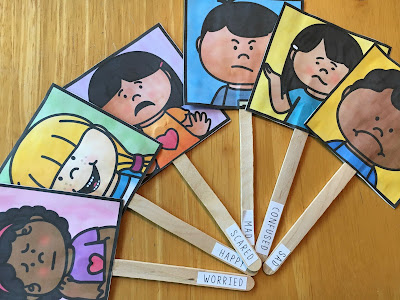Today I'm still thinking about my ASCA@Home presentation; I received some kind feedback yesterday, from a Counselor in Maine who said that it felt like she was in the room with me when I was presenting.
So I recorded a similar PD session on empathy, compassion & kindness for some educators in Canada; grab some tea and click {here} if you'd like to download and watch it.
The more I work with empathy, the more I realize the importance of modeling, fostering, nurturing and teaching emotional literacy.
So we've created Emotion Pops for our Virtual Survival Guide,
on sale now for $15 via the Add To Cart PayPal button
on the right-hand side of my blog's home page.
These colorful Printables are designed to be printed on card stock, cut out, and glued to a stick (or hole-punched and put on a O ring) to help our young students learn about and make friends with all of their emotions.
Even the uncomfortable ones. Like shocked or surprised.
Ask students to practice matching their face with a Feelings Word.
Does it match the one on the Emotion Pop?
Or does their angry, sad, happy, frustrated or scared look different?
Use Emotion Pops to get an emotional barometer during morning circle; ask for a thumbs up if this is how you're feeling today as you show each Pop. Or show an Emotion Pop and ask them to talk about a time they felt that way or when they saw someone feeling that way, maybe a friend or family member in real life or a character in one of their favorite books, movies, or TV shows.
Enter empathy. Once we can identify our own feelings,
we will be better at stepping into someone else's story
to imagine what they're experiencing and feeling.
Because we can't give away what we don't have yet.
What about when we have two (or more) emotions co-occurring?
Hungry and angry? Invite your students to make their own version of an Emotion Pop by drawing how their face looks when they're hangry. What other emotions might choose them at the same time?
This could beautifully dovetail into a discussion about
reading emotions when part of our faces is covered by a mask.
Use the sticky part at the top of a PostIt note to make a fun face covering;
better yet, cut one out for each child and let them create their own mask!
Can we tell how someone is feeling just by their eyes and through their body language? Encourage students to explore how their own eyes look, what happens to the muscles in their forehead and brow, how their cheeks look and feel, what their shoulders do, how their hands feel, how their stomach feels through all of the emotions, to foster emotional regulation as well as to elevate empathy.
What other ways might you use Emotion Pops either in person
or through remote learning to support SEL in your character building?























No comments
I really enjoy hearing from my readers; thanks for sharing your reflections with us!